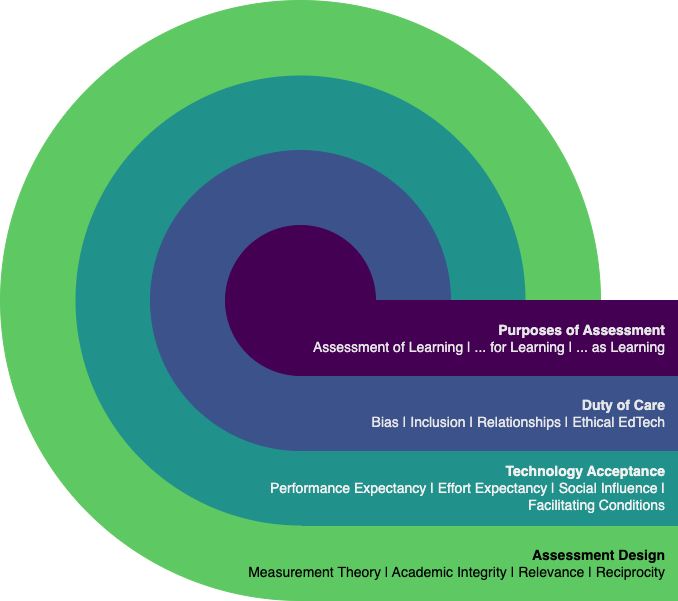flowchart TD classDef purpose fill:#440154,color:#fff,stroke:#440154,stroke-width:4px classDef duty fill:#3B528B,color:#fff,stroke:#3B528B,stroke-width:4px classDef accept fill:#21918c,color:#fff,stroke:#21918c,stroke-width:4px classDef design fill:#5EC962,color:#000,stroke:#5EC962,stroke-width:4px A[Technology-Integrated Assessment] --- B(Assessment Purpose) A(Technology-Integrated Assessment) --- C(Duty of Care) A(Technology-Integrated Assessment) --- D(Technology Acceptance) A(Technology-Integrated Assessment) --- E(Assessment Design) B --- F([Assessment of Learning]) --- G([Assessment for Learning]) --- H([Assessment as Learning]) C --- I([Bias]) --- J([Inclusion]) --- K([Relationships]) --- L([Ethical EdTech]) D --- M([Performance Expectancy]) --- N([Effort Expectancy]) --- O([Social Influence]) --- P([Facilitating Conditions]) E --- Q([Measurement Theory]) --- R([Academic Integrity]) --- S([Relevance]) --- T([Reciprocity]) class B,F,G,H purpose class C,I,J,K,L duty class D,M,N,O,P accept class E,Q,R,S,T design
Technology-integrated Assessment Scale
1University of Victoria, 2Queens University, 3University of Alberta
2025-06-06
Developing the Technology-integrated Assessment Scale
Acknowledgements
Our team is spread across most of the country and we each live and work on land that has been cared for by Indigenous people for millenia. We each acknowledge that our abundant lives were made possible because of the displacement of the original stewards of the land.
https://cmad.land
- click ‘Slides’
Background - OTESSA24
Evolving our understanding of technology-integrated assessment: A review of the literature and development of a new framework
Two Papers
Madland, C., Irvine, V., DeLuca, C., & Bulut, O. (2024b). Technology-Integrated Assessment: A Literature Review. The Open/Technology in Education, Society, and Scholarship Association Journal, 4(1), 1–48. https://doi.org/10.18357/otessaj.2024.4.1.57
Madland, C., Irvine, V., DeLuca, C., & Bulut, O. (2024a). Developing the Technology-Integrated Assessment Framework. The Open/Technology in Education, Society, and Scholarship Association Journal, 4(1), 1–19. https://doi.org/10.18357/otessaj.2024.4.1.63
Technology-integrated Assessment Framework (TIAF)
4 Components
Assessment Design
Technology Acceptance
Duty of Care
Purposes of Assessment

Full Model
Alt-View
Differentiation
- 5Rs of Indigenous Education (Tessaro et al., 2018)
- Relationship
- Respect
- Responsibility
- Relevance
- Reciprocity
Differentiation
- Duty of Care
- Bias
- Inclusion
- Relationships
- Ethical EdTech
Differentiation
- Technology Acceptance (Venkatesh et al., 2003)
- Performance Expectancy
- Effort Expectancy
- Social Influence
- Facilitating Conditions
Analysis
Exploratory Factor Analysis
- specify constructs
- identify parameters
- generate and refine items
- content validity
Table of Specifications
Parameters
Note: Archived /WIP/
Draft Questions
Pilot Questions
Content Validity
Expert Reviews
Next Steps
- pilot study @UVic
- scale revisions
- 3 items per construct
- Survey administration acros BC PSE
Funding and Support
This research was supported by the BCcampus Research Fellows Program, which provides B.C. post-secondary educators and students with funding to conduct small-scale research on teaching and learning, as well as explore evidence-based teaching practices that focus on student success and learning.
References

Special thanks to BCcampus